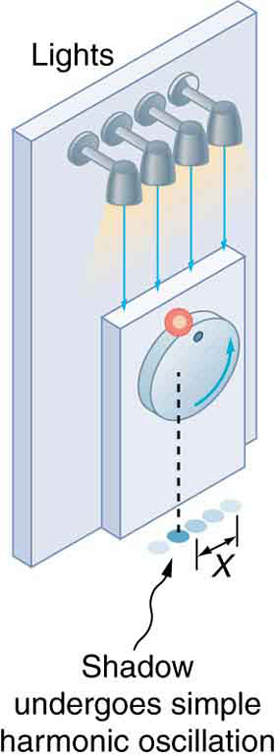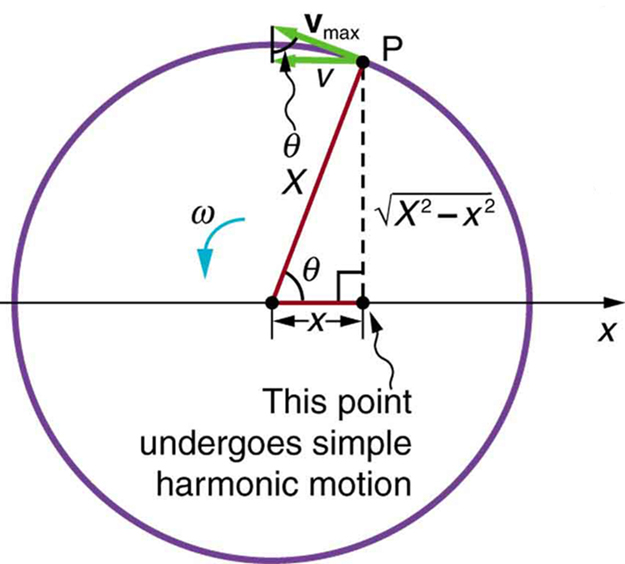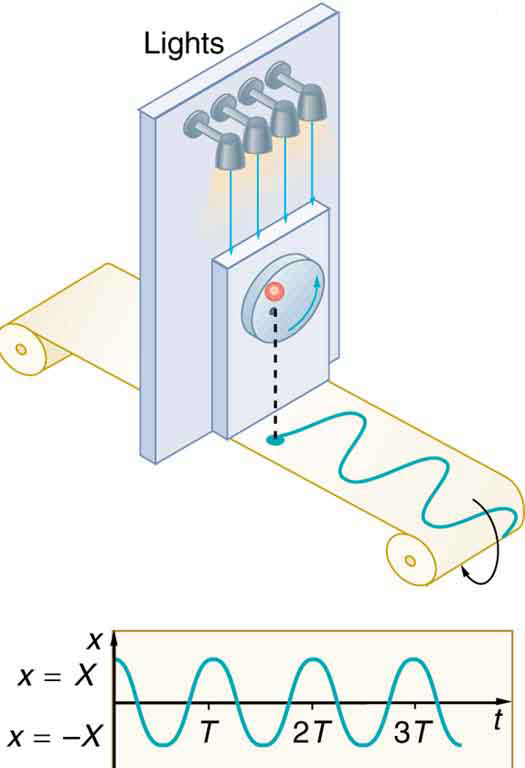Oscillatory Motion and Waves and Physics of Hearing.
121 Uniform Circular Motion and Simple Harmonic Motion
Learning Objectives
- Compare simple harmonic motion with uniform circular motion.

You can produce simple harmonic motion (SHM) by projecting uniform circular motion. In Figure 121.2, a ball rotates on a vertical turntable and casts a shadow on the floor. That shadow moves back and forth in SHM.

Figure 121.3 illustrates how the projection of a point in uniform circular motion behaves like an object in SHM. A point [latex]P[/latex] moves around a circle with constant angular velocity [latex]\omega[/latex]. The horizontal projection of [latex]P[/latex] is position [latex]x[/latex], and its horizontal velocity is [latex]v[/latex], derived from the circular velocity [latex]{v}_{\text{max}}[/latex].

The position of the shadow or projection is given by:
Since [latex]\theta = \omega t[/latex], we can write:
Substituting [latex]\omega = \frac{2\pi}{T}[/latex] gives:
This is the same position function for SHM derived earlier in the study of oscillations. The wavelike character of the motion is evident in Figure 121.4.

Mathematical Relationship
From Figure 121.3, velocity [latex]v[/latex] at position [latex]x[/latex] is:
This matches the velocity derived from conservation of energy in SHM. The period of the circular motion is the time to complete one revolution, or:
Using [latex]{v}_{\text{max}} = \sqrt{\frac{k}{m}} X[/latex], we substitute:
Which gives us:
This is the period of a simple harmonic oscillator, confirming the equivalence.
Check Your Understanding
Section Summary
- The projection of an object in uniform circular motion follows simple harmonic motion.
- The mathematical descriptions for SHM can be derived from the geometry of circular motion.
- The relationship helps explain physical waveforms, resonance, and systems such as pendulums and springs.
Problems & Exercises
- (a)What is the maximum velocity of an 85.0-kg person bouncing on a bathroom scale having a force constant of [latex]1\text{.}\text{50}×{\text{10}}^{6}\phantom{\rule{0.25em}{0ex}}\text{N/m}[/latex], if the amplitude of the bounce is 0.200 cm? (b)What is the maximum energy stored in the spring?
- A novelty clock has a 0.0100-kg mass object bouncing on a spring that has a force constant of 1.25 N/m. What is the maximum velocity of the object if the object bounces 3.00 cm above and below its equilibrium position? (b) How many joules of kinetic energy does the object have at its maximum velocity?
- At what positions is the speed of a simple harmonic oscillator half its maximum? That is, what values of [latex]x/X[/latex] give [latex]v=±{v}_{\text{max}}/2[/latex], where [latex]X[/latex] is the amplitude of the motion?
- A ladybug sits 12.0 cm from the center of a Beatles music album spinning at 33.33 rpm. What is the maximum velocity of its shadow on the wall behind the turntable, if illuminated parallel to the record by the parallel rays of the setting Sun?
the oscillatory motion in a system where the net force can be described by Hooke’s law
the motion of an object in a circular path at constant speed

